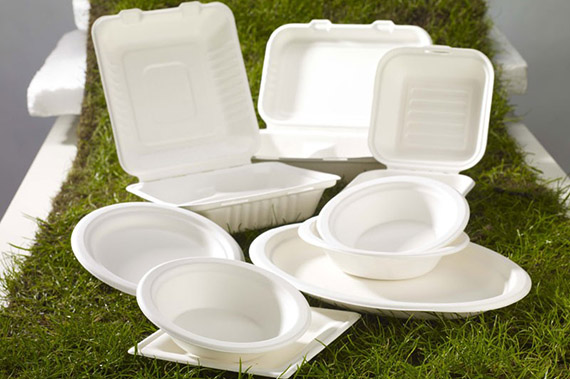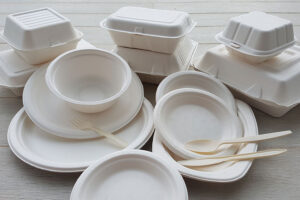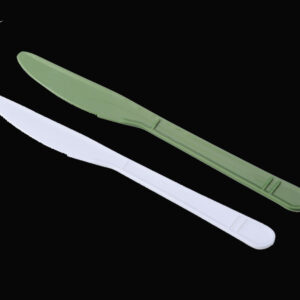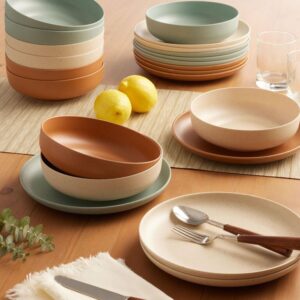Regarding sustainability and eco-friendly alternatives, the market for biodegradable cutlery is proliferating. Businesses and individuals seek ways to reduce their carbon footprint and contribute to a greener future. Two popular options that have gained significant attention are cornstarch cutlery and sugarcane cutlery. In this blog post, we will explore the differences between these two types of biodegradable tableware and delve into what sets corn starch cutlery apart from sugarcane cutlery.


Corn Starch Cutlery: An Overview
Corn starch cutlery, or PLA (Polylactic Acid), is made from renewable resources such as corn starch. It is a plant-based material that is derived from corn kernels. The production process involves extracting the starch from corn and transforming it into a biopolymer through fermentation. This biopolymer can be molded and shaped to create utensils like spoons, forks, and knives.
Sugarcane Cutlery: An Overview
On the other hand, Sugarcane cutlery is made from bagasse, a byproduct of sugarcane processing. Bagasse is the fibrous residue left over after the juice has been extracted from sugar cane. Through heat and pressure, bagasse is transformed into a pulp-like substance, which is then molded into various shapes to create eco-friendly utensils.
What Makes Corn Starch Cutlery Different?
Material Composition
One of the critical differences between corn starch cutlery and sugarcane cutlery is their material composition. Cornstarch cutlery is derived from a versatile crop widely cultivated worldwide. On the other hand, Sugarcane cutlery is made from the remnants of sugarcane processing, utilizing a byproduct that would otherwise go to waste.
Appearance and Texture
Corn starch cutlery has a smooth and glossy finish, resembling traditional plastic cutlery. It is available in a variety of colors and can be transparent. On the other hand, sugarcane cutlery has a more natural and rustic appearance, with a slightly rough texture due to the fibrous nature of bagasse. It is usually off-white or beige, and its surface may vary depending on the manufacturing process.
Strength and Durability
Corn starch cutlery tends to be more robust and reliable regarding strength and durability. It can stand at higher speeds and is less likely to bend or break during use. Sugarcane cutlery, while sturdy, may have slightly less resistance to heat and may need to be handled with a bit more care.
Biodegradability and Compostability
Both cornstarch cutlery and sugarcane cutlery are considered biodegradable and compostable. However, the composting processes for these materials differ. Corn starch cutlery requires specific industrial composting conditions, including high heat and humidity, to break down effectively. It may take three to six months to biodegrade in the right composting environment fully. On the other hand, Sugarcane cutlery can break down in both industrial composting facilities and home composting systems. Composting takes longer than Cornstarch cutlery, typically around six to twelve months.
Eco-Friendliness
Corn starch and sugarcane cutlery offer significant environmental benefits compared to traditional plastic cutlery. However, the sustainability of each material varies based on their production processes. Corn starch requires cultivating and harvesting corn, which can have specific environmental impacts such as land use and water consumption. Sugarcane, on the other hand, is a highly efficient and renewable crop. It multiplies and requires less land and water compared to corn production. Therefore, sugarcane cutlery may have a slight edge regarding resource efficiency and lower environmental impact.
Which Cutlery Option Should You Choose?
The choice between corn starch and sugarcane cutlery ultimately depends on your needs and preferences. If you require cutlery with a smooth and glossy finish, cornstarch cutlery may be the ideal choice for you. On the other hand, if you prefer a more natural and rustic appearance, sugarcane cutlery could be the perfect fit.
Consider the intended use and handling conditions of the cutlery. If you require utensils that can withstand high temperatures, Cornstarch cutlery may be the more suitable option due to its superior strength and durability. However, if heat resistance is not a significant factor, sugarcane cutlery can still offer reliable performance.
It is essential to ensure that the composting facilities available to you can accommodate the biodegradation requirements of the cutlery you choose. Where access to industrial compost facilities is open, both corn starch cutlery and sugarcane cutlery can be responsibly disposed of through these channels. However, if home composting is your preferred method, sugarcane cutlery may provide more flexibility and convenience.
As mentioned earlier, the sustainability of corn starch and sugarcane cutlery depends on various factors. While both options significantly reduce plastic waste, sugarcane cutlery has an advantage in resource efficiency due to using bagasse, a byproduct of sugarcane processing.
Take the Next Step in Sustainable Dining
Whether you choose corn starch or sugarcane cutlery, both options represent a significant step towards a more sustainable future. By opting for these eco-friendly alternatives, you can help reduce waste and positively impact the environment.
Numerous suppliers offer these products if you’re in the market to buy corn starch tableware in bulk or invest in sugarcane cutlery. Look for trusted manufacturers who prioritize sustainability and quality. Consider factors such as certifications, reputation, and customer reviews when deciding.
Remember, every small change counts when it comes to sustainability. By opting for biodegradable cutlery, you can protect our planet and promote a greener lifestyle. So, switch to cornstarch or sugarcane cutlery today and be a part of the positive change.







